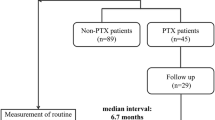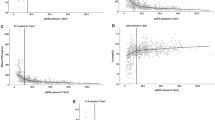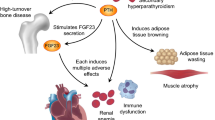Abstract
Summary
Fibroblast growth factor 23(FGF23) is a bone-derived hormone which regulates mineral homeostasis but may also have a role in cardiovascular disease. Here, we found that higher plasma FGF23 was independently associated with decreased heart rate variability in stage 5 CKD patients and parathyroidectomy may reverse these abnormal indicators.
Introduction
Lower heart rate variability (HRV) in patients with chronic kidney disease (CKD) compared with healthy controls is associated with increased risk of cardiovascular disease (CVD). Higher levels of plasma FGF23 also predict higher risk of CVD. Here, we aimed to evaluate the relationship between plasma FGF23 levels and HRV in patients with stage 5 CKD and to investigate longitudinal changes of them together with the correlation between their changes in two severe secondary hyperparathyroidism (SHPT) subgroups with successful parathyroidectomy (PTX) and persistent SHPT.
Methods
This cross-sectional study included 100 stage 5 CKD patients, 78 controls, and a prospective study in two PTX subgroups classified as successful PTX (n = 24) and persistent SHPT (n = 4) follow-up. Blood examination and 24-h Holter monitoring for HRV were measured.
Results
Most HRV indices were lower in stage 5 CKD patients than in healthy controls, and plasma FGF23 levels were higher. In multivariate stepwise regression models, levels of plasma FGF23 and serum parathyroid hormone (PTH) were correlated with HRV. The successful PTX subgroup had significant improvements over baseline in HRV indices. Persistent SHPT subgroup had numerically similar changes in HRV indices. However, plasma FGF23 levels decreased in both subgroups.
Conclusions
Plasma FGF23 levels were higher in CKD patients than in controls, much higher in patients with severe SHPT. FGF23 was independently associated with decreased HRV in stage 5 CKD. Successful PTX may reverse these abnormal indicators and contribute to decreases in the risk of cardiovascular disease.

Similar content being viewed by others
References
Go AS et al (2004) Chronic kidney disease and the risks of death, cardiovascular events, and hospitalization. N Engl J Med 351(13):1296–1305
Collins AJ et al (2014) US renal data system 2013 annual data report. Am J Kidney Dis 63(1 Suppl):A7
KDIGO clinical practice guideline for the diagnosis, evaluation, prevention, and treatment of chronic kidney disease-mineral and bone disorder (CKD-MBD). Kidney Int Suppl, 2009 (113): p. S1-130
Cunningham J, Locatelli F, Rodriguez M (2011) Secondary hyperparathyroidism: pathogenesis, disease progression, and therapeutic options. Clin J Am Soc Nephrol 6(4):913–921
Rubinger D et al (1999) Heart rate variability during chronic hemodialysis and after renal transplantation: studies in patients without and with systemic amyloidosis. J Am Soc Nephrol 10(9):1972–1981
Zhang J et al (2013) Parathyroidectomy and heart rate variability in patients with stage 5 CKD. Clin J Am Soc Nephrol 8(8):1378–1387
Quarles LD (2008) Endocrine functions of bone in mineral metabolism regulation. J Clin Invest 118(12):3820–3828
Shimada T et al (2004) FGF-23 transgenic mice demonstrate hypophosphatemic rickets with reduced expression of sodium phosphate cotransporter type IIa. Biochem Biophys Res Commun 314(2):409–414
Ben-Dov IZ et al (2007) The parathyroid is a target organ for FGF23 in rats. J Clin Invest 117(12):4003–4008
Shimada T et al (2004) FGF-23 is a potent regulator of vitamin D metabolism and phosphate homeostasis. J Bone Miner Res 19(3):429–435
Isakova T et al (2011) Fibroblast growth factor 23 and risks of mortality and end-stage renal disease in patients with chronic kidney disease. JAMA 305(23):2432–2439
Kendrick J et al (2011) FGF-23 associates with death, cardiovascular events, and initiation of chronic dialysis. J Am Soc Nephrol 22(10):1913–1922
Parker BD et al (2010) The associations of fibroblast growth factor 23 and uncarboxylated matrix Gla protein with mortality in coronary artery disease: the heart and soul study. Ann Intern Med 152(10):640–648
Gutierrez OM et al (2009) Fibroblast growth factor 23 and left ventricular hypertrophy in chronic kidney disease. Circulation 119(19):2545–2552
Desjardins L et al (2012) FGF23 is independently associated with vascular calcification but not bone mineral density in patients at various CKD stages. Osteoporos Int 23(7):2017–2025
Charra B et al (1996) Clinical assessment of dry weight. Nephrol Dial Transplant 11(Suppl 2):16–19
Sinha AD, Light RP, Agarwal R (2010) Relative plasma volume monitoring during hemodialysis AIDS the assessment of dry weight. Hypertension 55(2):305–311
K/DOQI clinical practice guidelines for bone metabolism and disease in chronic kidney disease. Am J Kidney Dis, 2003. 42(4 Suppl 3): p. S1-201
Kara M et al (2010) Evaluation of intraoperative parathormone measurement for predicting successful surgery in patients undergoing subtotal/total parathyroidectomy due to secondary hyperparathyroidism. Laryngoscope 120(8):1538–1544
Fukuta H et al (2003) Prognostic value of heart rate variability in patients with end-stage renal disease on chronic haemodialysis. Nephrol Dial Transplant 18(2):318–325
Roumelioti ME et al (2010) Abnormal nocturnal heart rate variability response among chronic kidney disease and dialysis patients during wakefulness and sleep. Nephrol Dial Transplant 25(11):3733–3741
Hayano J et al (1999) Prognostic value of heart rate variability during long-term follow-up in chronic haemodialysis patients with end-stage renal disease. Nephrol Dial Transplant 14(6):1480–1488
Schroeder EB et al (2005) Diabetes, glucose, insulin, and heart rate variability: the atherosclerosis risk in communities (ARIC) study. Diabetes Care 28(3):668–674
Weber TJ et al (2003) Serum FGF23 levels in normal and disordered phosphorus homeostasis. J Bone Miner Res 18(7):1227–1234
Heart rate variability. Standards of measurement, physiological interpretation, and clinical use. Task Force of the European Society of Cardiology and the North American Society of Pacing and Electrophysiology. Eur Heart J, 1996. 17(3): p. 354–81
Chan CT et al (2010) Determinants of cardiac autonomic dysfunction in ESRD. Clin J Am Soc Nephrol 5(10):1821–1827
Sarafidis PA et al (2012) Prevalence, patterns of treatment, and control of hypertension in predialysis patients with chronic kidney disease. Nephron Clin Pract 120(3):c147–c155
Routledge HC, Chowdhary S, Townend JN (2002) Heart rate variability—a therapeutic target? J Clin Pharm Ther 27(2):85–92
Kestenbaum B et al (2005) Serum phosphate levels and mortality risk among people with chronic kidney disease. J Am Soc Nephrol 16(2):520–528
Nasri H, Baradaran A (2004) Close association between parathyroid hormone and left ventricular function and structure in end-stage renal failure patients under maintenance hemodialysis. Bratisl Lek Listy 105(10–11):368–373
Polak G et al (2004) Effect of parathormone on heart rate variability in hemodialysis patients. Auton Neurosci 115(1–2):94–98
Gutierrez OM et al (2008) Fibroblast growth factor 23 and mortality among patients undergoing hemodialysis. N Engl J Med 359(6):584–592
Gutierrez O et al (2005) Fibroblast growth factor-23 mitigates hyperphosphatemia but accentuates calcitriol deficiency in chronic kidney disease. J Am Soc Nephrol 16(7):2205–2215
Wang N et al (2008) Vascular PPARgamma controls circadian variation in blood pressure and heart rate through Bmal1. Cell Metab 8(6):482–491
Gianaros PJ et al (2005) A greater reduction in high-frequency heart rate variability to a psychological stressor is associated with subclinical coronary and aortic calcification in postmenopausal women. Psychosom Med 67(4):553–560
Longenecker JC et al (2009) Association of low heart rate variability with atherosclerotic cardiovascular disease in hemodialysis patients. Med Princ Pract 18(2):85–92
Saleh FN et al (2003) Parathyroid hormone and left ventricular hypertrophy. Eur Heart J 24(22):2054–2060
Faul C et al (2011) FGF23 induces left ventricular hypertrophy. J Clin Invest 121(11):4393–4408
Cheung BM, Ong KL, Wong LY (2009) Elevated serum alkaline phosphatase and peripheral arterial disease in the United States National Health and Nutrition Examination Survey 1999–2004. Int J Cardiol 135(2):156–161
Evenepoel P et al (2005) Impact of parathyroidectomy on renal graft function, blood pressure and serum lipids in kidney transplant recipients: a single centre study. Nephrol Dial Transplant 20(8):1714–1720
Naranda J, Ekart R, Pecovnik-Balon B (2011) Total parathyroidectomy with forearm autotransplantation as the treatment of choice for secondary hyperparathyroidism. J Int Med Res 39(3):978–987
Chow KM et al (2003) Improved health-related quality of life and left ventricular hypertrophy among dialysis patients treated with parathyroidectomy. J Nephrol 16(6):878–885
Takahashi H et al (2014) Impact of parathyroidectomy on serum FGF23 and soluble Klotho in hemodialysis patients with severe secondary hyperparathyroidism. J Clin Endocrinol Metab: p. jc20134050
Sharma J et al (2012) Improved long-term survival of dialysis patients after near-total parathyroidectomy. J Am Coll Surg 214(4):400–407, discussion 407–8
Richards ML et al (2006) Parathyroidectomy in secondary hyperparathyroidism: is there an optimal operative management? Surgery 139(2):174–180
Acknowledgments
This study was funded by the National Natural Science Foundation of China (81270408), RC201162, 2010 (IB10), Chinese Society of Nephrology (13030300415), 2013-wsn-058 and PAPD. The authors would like to thank Chengjing Yan and Qiaodi Zhang for assistance with the measurement of laboratory indices; Yun Xia, Zhihui Song, and Jing Tu for assistance with the analysis of heart rate variability; Feng Chen and Min Cai for assistance with statistical analyses; and Cuiping Liu for the management of blood samples.
Conflicts of interest
None.
Author information
Authors and Affiliations
Corresponding authors
Additional information
L-N. Zhang and G. Yang contributed equally to this work.
Electronic supplementary material
Below is the link to the electronic supplementary material.
Supplemental Fig. 1
Comparison of laboratory values in persistent SHPT patients before and after PTX. Plasma levels of (A) FGF23, serum levels of (B) PTH, (C) Ca, (D) P, (E) ALP, and (F) Alb preoperative and postoperative. Data are mean±SD (n=4). *P<0.05. FGF23, fibroblast growth factor 23; PTH, parathyroid hormone; Ca, calcium; P, phosphorus; ALP, alkaline phosphatase; Alb, albumin; SHPT, secondary hyperparathyroidism; PTX, parathyroidectomy. (GIF 35 kb)
Rights and permissions
About this article
Cite this article
Zhang, LN., Yang, G., Cheng, C. et al. Plasma FGF23 levels and heart rate variability in patients with stage 5 CKD. Osteoporos Int 26, 395–405 (2015). https://doi.org/10.1007/s00198-014-2862-7
Received:
Accepted:
Published:
Issue Date:
DOI: https://doi.org/10.1007/s00198-014-2862-7




